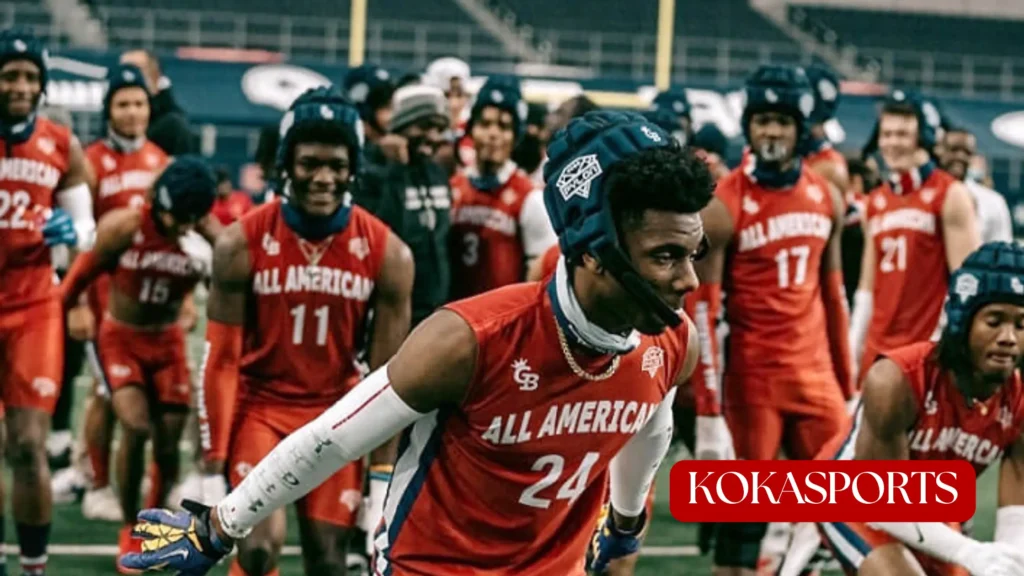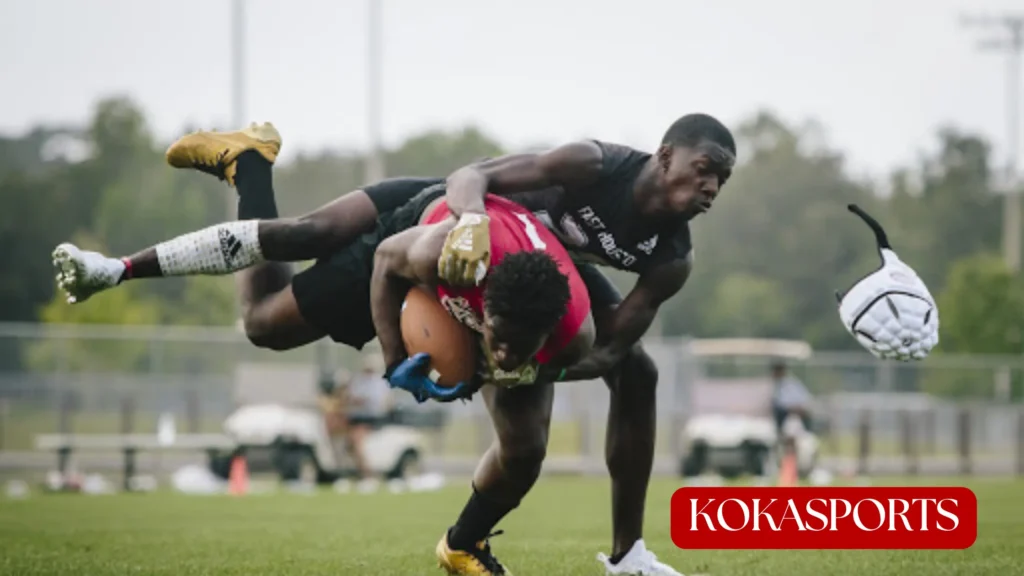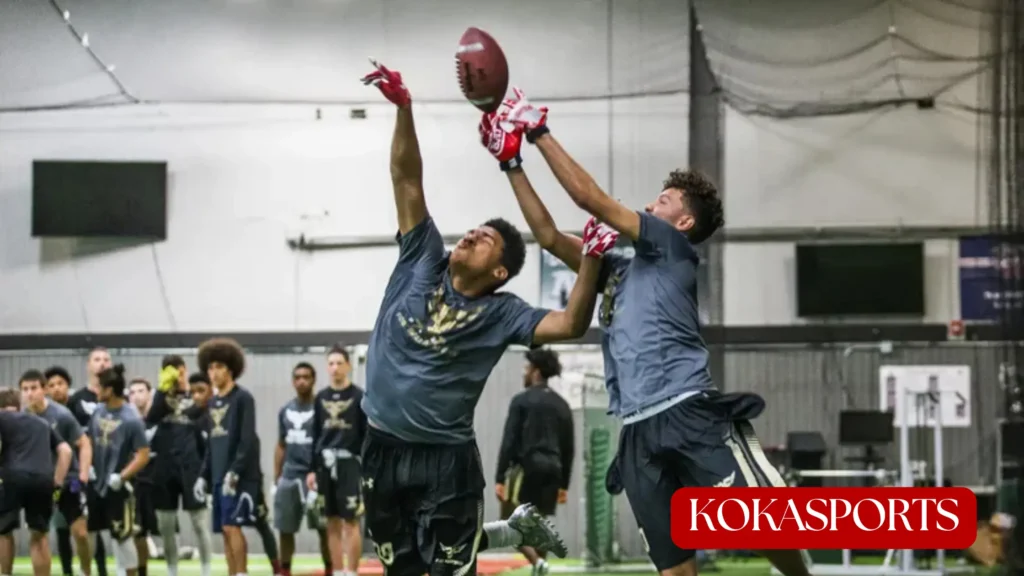What Is 7 on 7 Football?
7 on 7 football is a modified version of American football played with seven players on each side of the ball instead of the traditional 11 players. This exciting brand of football removes the linemen from both teams and focuses entirely on the passing game, creating a fast-paced environment where skill position players can showcase their abilities without the physical contact of traditional tackle football.
Unlike regular football, 7 on 7 eliminates blocking and tackling, making it a non-contact football format. The game centers around quarterbacks, receivers, and defensive backs competing in pure passing situations. There are no running plays allowed in 7 on 7, which means every snap results in a pass attempt. This unique format has exploded in popularity across the United States, with thousands of youth and high school players participating in organized leagues and tournaments each year.
The world of 7 on 7 operates differently than the traditional game. Teams line up on a smaller field, typically 40 yards in length and 40 yards wide, though dimensions can vary depending on the league. The offense gets four downs to score, and games are usually played in shorter formats with running clocks. Players wear cleats and mouthguards, and some leagues incorporate flags similar to flag football, while others use two-hand touch rules to end the play.
What makes this form of football special is how it allows players to hone their skills in specific areas. Wide receivers get countless repetitions running precise routes. Quarterbacks practice reading defenses and making quick decisions. Defensive backs work on their coverage techniques without worrying about blockers. This concentrated skill development has made 7v7 football an essential training tool for serious football players.
Read More: How to Throw a Football: Step-by-Step Guide to Throwing a Perfect Spiral
History and Origins of 7 on 7 Football

The roots of 7v7 can be traced back several decades when coaches began looking for ways to give their skill players extra work during the off-season. High school coaches wanted a format that would let quarterbacks and receivers build chemistry and timing without the injury risks that come with contact football.
Early versions of the game were informal, often played as practice drills or summer camp activities. Coaches would remove the linemen and have their offensive and defensive skill positions compete against each other. These sessions proved so valuable that organized competitions began emerging in the 1990s and early 2000s.
The popularity of 7 on 7 really took off in the 2000s when dedicated leagues started forming across Texas, Florida, and California. These states became hotbeds for competitive 7 on 7, with teams traveling to face elite competition. What started as simple passing drills evolved into highly organized tournaments with rules, officials, and championship events.
Today, the popularity of 7v7 football continues to grow rapidly. National organizations now run standardized leagues with divisions for different age groups. Major tournaments attract college coaches looking for recruiting prospects. The rise of social media and highlight videos has only accelerated this growth, as spectacular catches and defensive plays from 7v7 football games go viral and inspire more athletes to participate.
7 on 7 Football Rules – How 7v7 Games Work
Core Rule Changes
The football rules in 7 on 7 differ significantly from traditional tackle football. The most obvious change is the removal of the offensive line and defensive line. With no lineman on either side, the quarterback must release the ball quickly, and defenders can rush after a designated count (usually 3-4 seconds, though this varies by league).
Offensive players cannot run the ball forward. Every play must be a passing play. The quarterback receives the snap and must throw to one of their receivers. Some leagues allow one running back or slot player to serve as a check-down option, but true running plays are prohibited.
Defensive Rules and Coverage
Defensive players must cover receivers without making physical contact beyond what’s allowed in press coverage at the line. Most leagues enforce strict non-contact policies during the route and the catch. Defenders typically must pull the flag or make a two-hand touch to stop the ball carrier, depending on the league in question.
Defensive coverage strategies become crucial in this format. Teams can opt to play man-to-man coverage, where each defender is responsible for a specific receiver, or zone coverage, where players guard areas of the field. The absence of a pass rush (until after the designated count) means defensive backs must win with pure technique and positioning.
Scoring and Gameplay
| Scoring Event | Points |
|---|---|
| Touchdown | 6 points |
| Extra Point (close range) | 1 point |
| Extra Point (farther distance) | 2 points |
| Interception | Possession change |
| Safety | 2 points (rare) |
The field size varies, but most leagues use a smaller field than traditional football—typically a 40-yard playing area that’s easier to manage with fewer players. Games are usually played in two 20-minute halves with running clocks, though the goal of 7 on 7 remains the same as regular football: score more points than your opponent.
7 on 7 vs Tackle Football

The differences between these versions of the game are substantial. Tackle football involves blocking, tackling, running plays, and a full roster of positions including linemen. It’s a contact sport that requires full protective equipment and carries higher injury risks.
7v7 football, by contrast, is non-contact and eliminates the trenches entirely. There’s no offensive line protecting the quarterback, no defensive line trying to break through, and no fullbacks leading blocking assignments. This creates a completely different play style focused on speed, agility, and passing skills.
However, the benefits of 7 on 7 football extend beyond just safety. Players get many more repetitions in game-like situations. In traditional tackle football, a receiver might run 20-30 routes in a full game. In 7v7 football games, that same receiver could run 50-70 routes, dramatically increasing their development opportunities.
Many coaches use 7 on 7 as off-season training for their tackle football programs. High school football teams will compete in spring and summer 7v7 leagues to keep their skill position players sharp while reducing wear and tear on their bodies. The quarterback-receiver timing developed in these sessions directly translates to better execution during the fall season.
Is 7 on 7 Football Flag Football?
This is a common question, and the answer is: not always. While some leagues incorporate flags that players must pull to down the ball carrier, many competitive 7v7 leagues use a two-hand touch system instead. The distinction between 7v7 flag football and competitive 7 on 7 matters because they attract slightly different types of athletes.
Flag football is generally more recreational and welcoming to beginners. It’s commonly played in youth leagues and intramural settings. The flags provide a clear visual indicator of when a play is dead, making it easier to officiate.
Competitive 7v7 football leagues, especially those feeding into high school level programs, often skip the flags entirely. These leagues emphasize the development of football players who will eventually transition to tackle football. Though the goal of 7 on 7 remains centered on passing, the intensity and organization rivals traditional football programs.
Touch football (another term sometimes used interchangeably) typically refers to very casual games played without formal rules or organization. True 7 on 7 competitions have standardized rules, certified officials, and structured seasons.
Positions in 7v7 Football

Offensive Positions
The offense typically fields 7 players on the field: one quarterback, and six skill position players distributed among receivers, running backs, and tight ends. Here’s how positions break down:
Quarterback: The most important position in 7v7. They must read defenses quickly, make accurate throws, and manage the play clock without a line protecting them. Top quarterbacks in 7 on 7 develop elite decision-making abilities.
Wide Receivers: Usually 3-4 wide receivers on every play. These players must excel at route running, catching in traffic, and creating separation from defenders. Speed and hands are critical.
Running Back/Slot Players: Though they can’t run the ball forward, these players serve as check-down options and run routes from the backfield. They often match up against linebackers.
Tight Ends: Some formations include a tight end or slot player who can create mismatches against smaller defensive backs.
Defensive Positions
The defense also has 7 players on the field to match the offense:
Cornerbacks: These players cover the outside receivers and must have elite speed and technique. Positions like cornerback become even more important in 7 on 7 because they’re isolated without help from linebackers or a pass rush.
Safeties: Typically 2-3 safeties who provide deep coverage and help on routes. They must read the quarterback’s eyes and break on the ball.
Linebackers: Usually 1-2 linebackers who cover running backs and tight ends out of the backfield. They need to be athletic enough to run with skill players in space.
What Skills Do Players Develop in 7 on 7 Football?
The skill development opportunities in 7v7 are exceptional. Because the game of football is stripped down to its passing elements, players get incredibly focused practice on specific techniques.
Quarterbacks develop their ability to read defenses pre-snap, identify coverage schemes, and deliver accurate passes under pressure. Without a pocket to step up into, they must learn to set their feet quickly and trust their progressions. High school players who compete in 7v7 often show dramatic improvement in their passing game when tackle football season begins.
Route running becomes an art form in this environment. Receivers learn to create separation with subtle movements, sell routes with body language, and adjust to different coverage looks. They run the same routes dozens of times per session, ingraining muscle memory that serves them throughout their football careers.
Defensive players improve their coverage techniques, footwork, and ball skills. Defensive backs must stay in phase with receivers without using their hands to disrupt routes. This forces them to develop elite hip movement and anticipation skills.
The mental aspects of football also accelerate in 7v7. Players can take more mental reps because plays happen so quickly. They learn to recognize formations, predict plays based on down and distance, and make split-second decisions—all valuable skills that transfer directly to traditional tackle football.
Benefits of 7 on 7 Football
The advantages of this format are numerous and well-documented:
Faster Skill Development: With more repetitions in game situations, players improve much faster than they would in traditional football practice alone. A single tournament might provide as much passing practice as several weeks of regular practice.
Injury Prevention: The non-contact nature of 7v7 football dramatically reduces injury risks. Football players can compete at high intensity without the concussions, broken bones, and ligament injuries common in contact football. This allows year-round participation without the physical toll.
Off-Season Conditioning: Teams use 7 on 7 to maintain fitness and sharpness during the spring and summer months. Players stay in football shape and continue developing their skills rather than losing progress during the off-season.
Team Chemistry: Playing together in 7v7 helps quarterbacks and receivers build timing and trust. These connections become invaluable when the team returns to high school football competition in the fall.
Recruiting Exposure: College coaches attend major 7 on 7 tournament events specifically to evaluate prospects. Athletes who excel in these settings often receive scholarship offers. The 7-on-7 league offers athletes an exceptional platform to showcase their abilities in front of scouts.
7v7 Leagues – How to Join
Finding a 7v7 league has become easier as the sport has grown. Most communities with organized youth or high school football programs now have associated 7 on 7 teams. Football leagues operate at local, regional, and national levels.
Local leagues typically run during spring and summer months, with practices during the week and games on weekends. These are often organized by high school coaches who want to develop their players during the off-season.
Travel leagues involve teams competing against opponents from other cities or states. These require more commitment and higher costs but provide better competition and exposure.
National leagues like the 7-on-7 passing league circuit host major tournaments that attract elite teams from across the country. Though expenses for travel, entry fees, and equipment can add up, these events offer the best recruiting opportunities for serious players.
Cost varies widely. Some community-based programs charge minimal fees ($50-100 per season), while elite travel teams might cost $500-1,000 or more when factoring in tournament entries, uniforms, and travel expenses.
Training and Conditioning for 7v7 Football
Preparing for 7v7 requires specific training approaches. Unlike traditional tackle football, players need to emphasize speed, agility, and endurance over raw strength.
Speed and Agility Work: Cone drills, ladder exercises, and sprint training become crucial. Players must be able to change direction quickly and accelerate out of breaks. The 40-yard dash time is less important than the first 10 yards of explosiveness.
Position-Specific Drills: Quarterbacks practice their drops, reads, and release points repeatedly. Defensive backs work on hip movement and transition techniques. Receivers focus on release moves off the line and catching in traffic.
Conditioning: The fast pace of 7v7 plays requires excellent cardiovascular fitness. Players might participate in 30-40 plays in a short tournament game, with minimal rest between snaps. This demands a higher level of endurance than traditional football, where players get breaks between each play.
Strategy in 7v7 Football
Offensive strategy in 7 on 7 centers on spread concepts and quick-read passing attacks. Teams often use four or five receiver sets and attack defenses horizontally and vertically. The focus on the passing game means quarterbacks must make faster decisions than in traditional tackle football.
Common passing plays include:
- Slants and quick outs
- Corner and post routes
- Mesh concepts that create rubs
- Flood patterns that overload zones
- Go routes that test defensive speed
Defensive strategy involves choosing between man and zone coverage based on opponent strengths. Some teams play aggressive man coverage and trust their defensive backs to win one-on-one. Others prefer zone concepts that keep everything in front and force offenses to be patient.
7 on 7 Football for Youth Athletes
Parents often ask: is 7 football can be played safely by younger children? The answer is generally yes. The non-contact nature makes it appropriate for youth athletes who want to learn football fundamentals without the physical risks of tackle football.
For young players, 7v7 provides an excellent transition path. They can learn football concepts, develop their skills, and enjoy competition in a safer environment. Many youth football players start in 7v7 before eventually moving to traditional tackle football once they’re older and their bodies are more developed.
The development benefits for young quarterbacks and receivers are particularly significant. These positions require thousands of repetitions to master, and starting in a 7v7 format allows players to get those reps earlier in their development.
7v7 Football and College Recruiting
College coaches absolutely pay attention to 7 on 7 performance. While they know it’s not a perfect evaluation tool—it doesn’t show blocking ability, toughness, or physicality—it does reveal pure athletic ability and skill positions technique.
Major exposure camps and tournaments attract dozens of college scouts. Elite events might have coaches from 20-30 universities watching games simultaneously. Athletes who dominate in these settings often see their recruiting profiles rise dramatically.
However, realistic expectations are important. 7v7 success alone won’t earn a scholarship. College coaches still need to see players in traditional football settings where they block, tackle, and show physicality. But strong 7 on 7 performance can open doors and generate initial recruiting interest that leads to further evaluation.
Common Misconceptions About 7 on 7 Football
“7v7 Football Replaces Tackle Football”
This is false. 7 on 7 complements tackle football but doesn’t replace it. The league is a fun competitive environment that develops specific skills, but the complete game of football requires elements that 7v7 doesn’t provide. Learning to block, tackle, and play with physicality remains essential for serious football players.
“7v7 Is Only for Skill Positions”
While skill players certainly benefit most directly, even athletes who will play lineman positions in traditional football can participate in 7v7. It helps them develop better football IQ and field awareness. Some big athletes play tight end or linebacker in 7v7 before moving to the line in tackle football.
“7v7 Doesn’t Matter for Real Game Situations”
Actually, the 7-on-7 passing league is a fun and incredibly relevant training tool. The passing concepts, defensive coverage schemes, and quarterback progressions used in 7v7 are identical to those used in the NFL. What players learn about reading defenses and running precise routes transfers directly to football game situations.
The Future of 7 on 7 Football
The growth trajectory of 7v7 shows no signs of slowing. More leagues form every year, tournament attendance increases, and media coverage expands. Major sports networks now broadcast championship events, and sponsorship money flows into the sport.
Some observers wonder if 7v7 will eventually become a sanctioned high school level sport with official championships, similar to how basketball and soccer operate. Currently, most 7 on 7 exists outside the official school sports structure, but that could change as its legitimacy grows.
The football is growing is due to several factors: concern about concussions in youth sports, the desire for year-round football activities, and the proven effectiveness of the format for skill development. As more parents seek safer alternatives and more players seek additional training opportunities, 7v7 fills both needs perfectly.
Conclusion – Why 7 on 7 Football Is Changing the Game
7v7 football represents a significant evolution in how American football is taught and played. By isolating the passing elements and creating a non-tackle football environment, it allows played with seven players and players on each side to develop elite skills without the injury risks of full-contact competition.
Football provides numerous benefits: faster skill development, better team chemistry, recruiting exposure, and safer year-round participation. Whether you’re a youth athlete just learning the game, a high school player trying to earn a college scholarship, or a football team looking for effective off-season training, 7 on 7 offers something valuable.
The league offers athletes an exceptional opportunity to improve their craft in a focused environment. Players wear lighter equipment, compete on a smaller field, and get far more repetitions than traditional football allows. This concentrated practice accelerates development in ways that traditional methods simply cannot match.
For anyone new to this brand of football, the best advice is simple: find a local league, attend some games to see how it works, and get involved. The football offers immediate action, constant learning, and a supportive community of players and coaches dedicated to the game. Whether 7 on 7 becomes your primary sport or serves as training for tackle football, the skills and experiences you gain will prove invaluable throughout your football journey.
FAQs
How do you play 7 on 7 football?
A non-contact, pass-only game with seven players per side trying to score through passing plays.
How does scoring work in 7 on 7 football?
Touchdowns are usually 6 points, with 1–2 point conversions and sometimes points for defensive stops.
What is the difference between flag football and 7v7?
Flag uses flag pulls for tackles, while 7v7 focuses on passing and skill development with no running plays.
What does 7v7 mean in football?
Seven offensive players vs seven defensive players instead of full 11-on-11.



